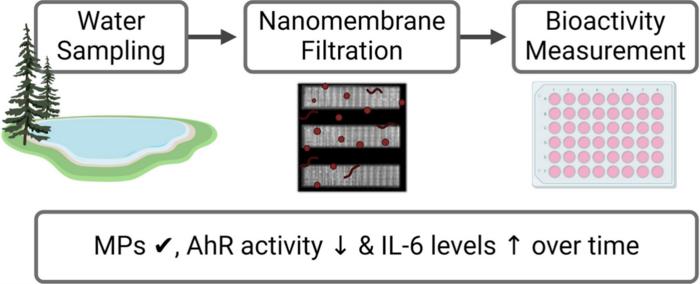A new study reveals the bioactivity of microplastics in Lake Ontario using cutting-edge nanomembrane filtering technology. Researchers found all samples contained microplastics ranging between 8 and 20 µm. The study highlights varying bioactivity levels, such as aryl hydrocarbon receptor (AhR) activity and IL-6 levels, indicating potential health risks. These findings underscore the urgent need for further research to comprehend the impact of microplastics on human health and the environment. This pioneering approach offers fresh insights into tackling the challenges posed by microplastic pollution.
Microplastics are a significant pollutant present in ecosystems worldwide, including oceans, lakes, and rivers. These particles pose potential health risks due to their persistence and complex composition, which includes various toxic chemicals. Prior research has highlighted the widespread presence of microplastics and their potential impact on human health. Based on these challenges, it is crucial to conduct in-depth studies on the bioactivity of microplastics in environmental samples to assess their health risks.
A study (DOI: 10.1016/j.eehl.2024.05.004) conducted by the University of Rochester Medical Center, published in Eco-Environment & Health on 29 May 2024, investigates the bioactivity of microplastics in Lake Ontario using silicon nitride nanomembrane technology. Researchers isolated debris between 8 and 20 µm from water samples collected at different times and locations. By analyzing cell viability, aryl hydrocarbon receptor (AhR) activity, and IL-6 levels, the study aims to provide insights into the potential health risks posed by microplastics.
The study utilized innovative nanomembrane filtering technology to isolate and analyze microplastic-containing debris from Lake Ontario. Researchers collected samples from four locations at different times, using silicon nitride nanomembrane filters to isolate debris between 8 and 20 µm. Nile Red staining confirmed the presence of microplastics in all samples. Cell-based assays assessed cell viability, AhR activity, and IL-6 levels, revealing that while microplastics were consistently present, their bioactivity varied over time. The isolated debris showed no impact on cell viability, indicating a lack of cytotoxicity. However, variations in AhR activity and IL-6 levels suggest that the bioactivity of microplastics depends on their physicochemical properties. The study emphasizes the need for more extensive sampling to fully characterize microplastic bioactivity and understand the influence of sample properties.
Dr. Sarah E. Morgan, lead researcher, stated, “Our findings demonstrate the potential health risks posed by microplastics in Lake Ontario. The variability in bioactivity observed highlights the importance of understanding the physicochemical properties of these particles. This study underscores the need for more extensive sampling and analysis to fully assess the health implications of microplastic exposure. The novel nanomembrane filtering technology we employed offers a promising approach for future research in this field.”
The implications of this research are far-reaching, offering a new methodology for environmental monitoring and health risk assessment. By enhancing our ability to detect and analyze microplastics, the study paves the way for more targeted strategies to mitigate plastic pollution and protect aquatic ecosystems. Moreover, the insights gained could inform regulatory measures and public health policies aimed at reducing exposure to these pervasive contaminants.

Credit: Eco-Environment & Health
A new study reveals the bioactivity of microplastics in Lake Ontario using cutting-edge nanomembrane filtering technology. Researchers found all samples contained microplastics ranging between 8 and 20 µm. The study highlights varying bioactivity levels, such as aryl hydrocarbon receptor (AhR) activity and IL-6 levels, indicating potential health risks. These findings underscore the urgent need for further research to comprehend the impact of microplastics on human health and the environment. This pioneering approach offers fresh insights into tackling the challenges posed by microplastic pollution.
Microplastics are a significant pollutant present in ecosystems worldwide, including oceans, lakes, and rivers. These particles pose potential health risks due to their persistence and complex composition, which includes various toxic chemicals. Prior research has highlighted the widespread presence of microplastics and their potential impact on human health. Based on these challenges, it is crucial to conduct in-depth studies on the bioactivity of microplastics in environmental samples to assess their health risks.
A study (DOI: 10.1016/j.eehl.2024.05.004) conducted by the University of Rochester Medical Center, published in Eco-Environment & Health on 29 May 2024, investigates the bioactivity of microplastics in Lake Ontario using silicon nitride nanomembrane technology. Researchers isolated debris between 8 and 20 µm from water samples collected at different times and locations. By analyzing cell viability, aryl hydrocarbon receptor (AhR) activity, and IL-6 levels, the study aims to provide insights into the potential health risks posed by microplastics.
The study utilized innovative nanomembrane filtering technology to isolate and analyze microplastic-containing debris from Lake Ontario. Researchers collected samples from four locations at different times, using silicon nitride nanomembrane filters to isolate debris between 8 and 20 µm. Nile Red staining confirmed the presence of microplastics in all samples. Cell-based assays assessed cell viability, AhR activity, and IL-6 levels, revealing that while microplastics were consistently present, their bioactivity varied over time. The isolated debris showed no impact on cell viability, indicating a lack of cytotoxicity. However, variations in AhR activity and IL-6 levels suggest that the bioactivity of microplastics depends on their physicochemical properties. The study emphasizes the need for more extensive sampling to fully characterize microplastic bioactivity and understand the influence of sample properties.
Dr. Sarah E. Morgan, lead researcher, stated, “Our findings demonstrate the potential health risks posed by microplastics in Lake Ontario. The variability in bioactivity observed highlights the importance of understanding the physicochemical properties of these particles. This study underscores the need for more extensive sampling and analysis to fully assess the health implications of microplastic exposure. The novel nanomembrane filtering technology we employed offers a promising approach for future research in this field.”
The implications of this research are far-reaching, offering a new methodology for environmental monitoring and health risk assessment. By enhancing our ability to detect and analyze microplastics, the study paves the way for more targeted strategies to mitigate plastic pollution and protect aquatic ecosystems. Moreover, the insights gained could inform regulatory measures and public health policies aimed at reducing exposure to these pervasive contaminants.
###
References
DOI
10.1016/j.eehl.2024.05.004
Original Source URL
https://doi.org/10.1016/j.eehl.2024.05.004
Funding information
This work was supported by the National Institute of Environmental Health Sciences (NIEHS R01 ES021492), the University of Rochester Toxicology Training Program (NIEHS T32 ES007026), and the University of Rochester Environmental Health Sciences Center (NIEHS P30 ES001247).
About Eco-Environment & Health
Eco-Environment & Health (EEH) is an international and multidisciplinary peer-reviewed journal designed for publications on the frontiers of the ecology, environment and health as well as their related disciplines. EEH focuses on the concept of “One Health” to promote green and sustainable development, dealing with the interactions among ecology, environment and health, and the underlying mechanisms and interventions. Our mission is to be one of the most important flagship journals in the field of environmental health.
Journal
Eco-Environment & Health
DOI
10.1016/j.eehl.2024.05.004
Subject of Research
Not applicable
Article Title
Assessing bioactivity of environmental water samples filtered using nanomembrane technology and mammalian cell lines
Article Publication Date
29-May-2024
COI Statement
The authors declare that they have no competing interests.




